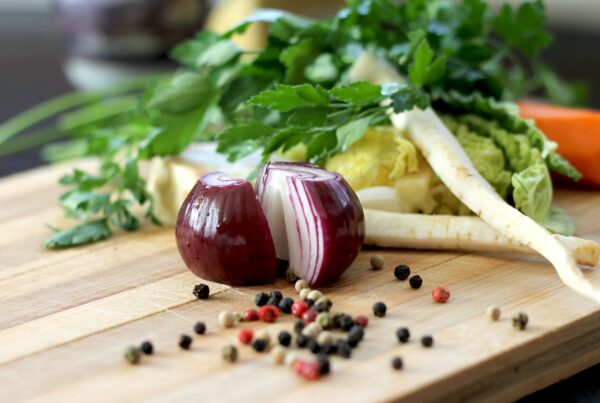What is a community meal, and why should you have one?
When our team first decided to write about hosting community meals, we talked about this question for a long time. There are all kinds of ways to have a meal with other people and all kinds of ways of gathering your community together. We realized that the definition of a community meal is simple and broad. A community meal is an occasion for gathering together with a group of people in order to share food and time together.
Community meals act as a biblical spiritual practice
As Christians, we gather together to eat, both with people we know and people we don’t know, because Jesus did. If you read through any of the Gospels, you will find Jesus eating with all kinds of people, in all kinds of situations. Jesus eats in homes, Jesus eats with crowds, and Jesus eats with his close friends.
In all of those situations, Jesus is sharing the good news of the gospel by being present with people, by engaging in some of life’s most basic and essential activities with them, and by spending time with them. If we follow Jesus’s example, we’ll probably be part of all kinds of community meals too. Food ministry is as wonderful a way to share the gospel and build community today as ever.
Church-wide lunch after Sunday service? That’s a community meal.
Neighborhood block party where you welcome lots of folks you’ve never met? Community meal.
Gathering with a small group for dinner and fellowship at your home? Community meal.
Any way that you gather people together and share in eating some good food is what we think of as a “community meal.” The question that we think is even more important for food ministry than “what is it?” is “how do you host a community meal well?”
How to host a community meal or dinner
As people who have been in and around the church for a long time, we’ve been to lots of community meals. Some have been great, and some not so much. The thing that sets a great community meal apart is intentional hospitality.
When a host takes time to think about the meal in advance, to consider who is coming and what they might need in order to feel welcomed, comfortable, and safe—and what we as the church can do to create that space—it provides an experience that is open and generous to everyone. But intentional hospitality takes time, and you have to know what questions to ask in order to plan well. Below, we’ve outlined a few of our top questions to help you engage with intentional hospitality as you plan for a community meal, and some of the details that go with them.
Key questions to ask yourself when you plan a community meal
Who will be at the table?
- Think about the group you’re hosting. Are they members of your church? Members of your wider community? Do you know them personally? Will they be bringing guests or family members?
- Who sits beside you and across the table matters. Jesus challenges the cultural norms of his time by communing with those at the margins. How can we learn from his example? Who is God calling you to be in relationship with in this season?
- Knowing who you’ve invited can help you think about what they might need. For example, will families need high chairs? Do you know how many people will come, or do you need to set out extra chairs?
- Consider how people will hear you if you are doing any kind of speaking. In large groups or spaces (like a church fellowship hall, cafeteria, or parking lot), always use a microphone. Even if you are simply giving directions to the food and offering a prayer, using a microphone will allow everyone, especially anyone who is hard of hearing, to hear and understand you. Even if you have a loud voice, don’t assume that everyone will be able to hear you.
How will you address food allergies or restricted diets?
- This is so important and often overlooked. There are a lot of people today who have food restrictions, allergies, or modified diets. These might be personal choices, but they might be related to serious medical conditions. And, they might not be known to you, even if you know someone well. If you want to create a safe space for people to eat together, don’t discount the importance of this issue. It could literally be a matter of life or death for some people.
- A lot of community meals have potlucks or buffet style food lines. This can be really great, because you get a lot of different dishes so, ideally, everyone can find something they like. However, you need to think about people who have allergies or people who have food restrictions (like people who are vegetarian and people who have conditions like Crohn’s disease). You and your guests might not know who has food restrictions or what they are, so think about how to let people know what is in food, so that they can feel safe making choices. Labels and ingredient lists are great for this.
- Please, don’t make people ask what is in a dish! The people serving the food might not be the people who made the food, so they might not actually know what the ingredients are.
- Consider providing a few options that meet the needs of the most common food restrictions, even if the event is a potluck. We’ve been to many events where someone attending had very limited options or even had to bring their own food. Providing dishes that are vegan (vegetarian AND dairy free), gluten free, and nut free make events much more welcoming, especially if you let everyone know that these options are available!
- Watch out for cross contamination. If you have gluten-free food, especially, make sure that it is not on the same plate as food containing gluten. Give gluten free rolls their own basket, with a cover. Make sure that each dish has its own serving utensils, so that people aren’t transferring food from one plate into another dish.
How will you help new people feel welcome?
- If you have an open meal, whether it is a small group where someone brings a friend or a neighborhood block party, it is important for people to feel welcomed. Make sure to have someone who will greet people warmly.
- If you have a group that already knows one another, whether it is your congregation or a group of friends, make sure you prioritize meeting and getting to know newcomers. Nothing is more disappointing than coming to a “community” gathering and not having anyone sit with you or engage you in good conversation. Encourage people to sit with someone they don’t know or haven’t seen in a while in order to disrupt any in-crowd vibes.
- As the host, lead with vulnerability. It can be tempting to curate a perfect version of yourself to impress or perform for those whom you are hosting. But leading with your authentic self can build more trust with those around you. Tim Keller says, “To be loved without being fully known is nice, but is superficial friendship; to be fully known and rejected is our deepest fear, but to be fully known and loved is the Gospel.” It’s a discipline for all of us to do, but it sets the table for deeper and more fruitful relationships.
No matter how your community meal looks, we hope you take joy in creating space for people to experience the love of Christ through food and fellowship.

Stephanie Soderstrom
Stephanie Soderstrom is coordinator for Short-term Mission for the Reformed Church in America. You can connect with her by email at ssoderstrom@rca.org.
Eduardo Rodriguez previously served the Reformed Church in America in the areas of local mission engagement and leadership.



